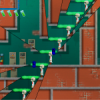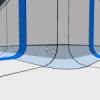Artsy 2D platformer-puzzlers have drunk in enough of the spotlight at this point that they’ve become a cliché unto themselves. It seems small developers are convinced that all they have to do is take some snazzy image effects filters, atmospheric music and throw in a twist in the form of a new-ish game mechanic and they’re done.
But not every game can be the next Braid or Limbo. Munin is one more game following this retro-modern-chic trend, and although it may not set itself wholly apart from the stable of one-mechanic-ponies out there, it still has enough of its own ideas to warrant its existence. If you’re the kind of person that enjoys solving macro-puzzles as much as micro-puzzles, you might enjoy the lateral mental workout Munin offers. And if you have no idea what that’s supposed to mean, keep reading.
Imagine, if you will, that the game screen is invisibly and evenly divided into 6-9 square panels. What Munin allows you to do is rotate these panels in 360 degrees, albeit in 90 degree rotations. The aim of the game is to guide Munin, Odin’s messenger who’s been cursed by Loki into taking the form of a little girl - yes, there’s some Norse mythology here - towards the raven feathers scattered across the stage sets. The norse mythology setting is little more than set dressing to be honest - there’s next to nothing in the way of a narrative or backstory - but it at least results in some interesting imagery.
The early levels are enough to provide a feel for how the rotation mechanic works in practice. In the first stage you start on the left-side of the screen, with a feather placed on the right. Between you and the feather is a stalacmite-like rocky protrusion. Munin can only muster a slow-moving, feeble jump, so going over the protrusion is impossible. The solution is simple enough: click on the panel with the rocky protrusion and rotate it upside-down, turning that stalacmite into a stalactite, allowing you to walk over to the feather.
Here’s where Munin’s first problem becomes apparent, though: stogdy controls. Your character has the athletic prowess of a pet rock by design, but the fact that the jump button responds with variable degrees of delay - or sometimes doesn’t respond at all - is a nuisance that sticks around for the entirety of Munin‘s roughly 8-hour playtime. With near non-existent load times we wouldn’t say it’s frustrating to have to re-attempt a stage because of a failed jump or fumbled ladder grab, but it’s an ever-present issue so it bears mentioning.
Munin’s base mechanics aren’t much more than running, jumping and rotating, but get deeper into the game and the number of feathers and the complexity of the stages increases dramatically. In one stage you have to first get feathers to materialize by rotating adjacent blocks to align and match up power runes. I had no trouble matching the runes and getting the feathers to appear, but that’s of little use when the correct configuration of screen panels re-arranges the lay of the land, making it impossible to get to the feather itself.
Here the macro-puzzle is figuring out what to do, realizing you need to rotate the runes to get the feathers to appear. Everything up until this point is an un-stimulating mix of trial-and-error and observation. But the micro-puzzle, the one you have to solve after you know what you need to do, is where the game comes into its own.
Once you realize which runes you need to align and which part of the screen you have to be on to collect the feather, the focus shifts from getting the feathers to appear to figuring out the correct order to re-jig each part of the screen whilst balancing being able to traverse the stage and reset the runes to their correct configuration. That’s the micro-puzzle, and when Munin focuses on them it’s at its best.
Sadly, as the stages grow in complexity, it’s easy to find yourself sinking more time into the macro-puzzle of simply figuring out what to do, prolonging the least satisfying part of the game. At least, this is the case when you’re still learning how to use the world specific mechanics. After clearing the first handful of levels, Munin opens up allowing you to jump in and out of different worlds - each with their own set of levels and level specific sub-mechanics. Since each world has its own difficulty curve, ranging from easy to hard, you normally have a small helping of other stages to try (in other worlds) should you get stuck.
Some of the world-specific mechanics are surprisingly modern-feeling, for what otherwise feels like a fairly traditional side-scrolling puzzler. In one world you have to rearrange screen blocks to alter a one-hit-kill lava flow away from you or any feathers. But these lava flows don’t snap into place along the path you set: they exhibit physics, tumbling and spraying when they meet corners or sharp angles. Turn a U-shaped lava-flow upside-down and you can tip it out into a bottomless chasm, or if you are quick enough you can abruptly alter lava flow direction, nip in and grab a feather and then rotate the flow back away from you before it closes in.
 As mentioned earlier, Munin starts to feel easier the deeper you get into the game. When this is down to having mastered the world’s mechanics you feel like a genius: In one stage you start out imprisoned in a cage and the macro-puzzle is immediately obvious - hit the switch to escape. The micro-puzzle, however, is a delicious mixture of all the the mechanics you’ve learned from the earlier stages. By re-arranging a series of tubes you’re able to guide a ball through a custom-made obstacle course with the switch at the end.
As mentioned earlier, Munin starts to feel easier the deeper you get into the game. When this is down to having mastered the world’s mechanics you feel like a genius: In one stage you start out imprisoned in a cage and the macro-puzzle is immediately obvious - hit the switch to escape. The micro-puzzle, however, is a delicious mixture of all the the mechanics you’ve learned from the earlier stages. By re-arranging a series of tubes you’re able to guide a ball through a custom-made obstacle course with the switch at the end.
But at times you feel like you’re moving through gaps in the Matrix, acutely aware of the designers’ intention. In certain levels the game boils down to observing which two panels line up together, ducking into an alcove near a panel boundary in one panel, and then rotating the adjacent panel around until a path presents itself.
However, with that said, after being stumped for up to 30 minutes it can be cathartic to snowball your way through several stages in quick succession. And most of your time with Munin will be spent enjoying long stints of progress, only to be followed by the occasional roadblock. This is a game that you can enjoy clicking at casually, but will enjoy best in hearty play sessions.
Munin doesn’t quite set itself apart from the pack of artsy puzzle-platformers out there. The norse mythology elements are the artiest part, but are only skin-deep, and with the lack of a narrative backbone it’s not quite as atmospheric as it could be. But don’t let the fact that it’s yet another puzzler built around a single mechanical twist deter you.
For better and worse, Munin rewards players with long stints of unimpeded progress. And occasionally it does what any decent puzzle game should - it makes you feel smart. It’s not the next Braid, but if you love the genre then it’s certainly worthy of consideration.









